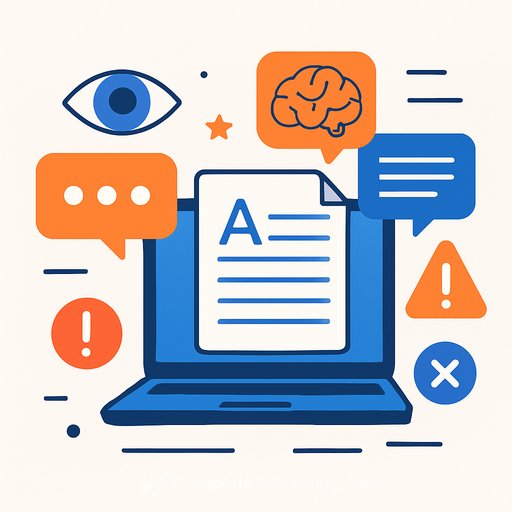How Writers Can Spot AI-Generated Text (And What To Do About It)
AI is everywhere. It can outline, draft and rewrite at a pace no human can match. That convenience comes with a cost: more generic prose, fuzzy facts and work that feels hollow.
If you edit client drafts, manage freelancers or accept guest posts, you'll face AI-written submissions. Here's a practical system to detect them and respond without wasting your time.
Quick tells that a draft was generated by AI
- Key terms from the brief are repeated too often, as if the tool is padding for relevance.
- Inaccurate or unverifiable facts show up due to hallucinations. Learn what "hallucinations" are.
- Sentences read clean but not natural-rhythms feel samey, transitions are stiff and qualifiers pile up.
- Explanations go in circles or restate the prompt instead of developing an original point.
- The tone doesn't match the writer's usual style or past samples.
Example: Ask "In 300 words or fewer, explain how this SWOT and brand audit will inform your final pitch." An AI-heavy answer often repeats "SWOT," "brand audit," and "final pitch" in every section, defining terms instead of applying them.
Use AI like a detective, not a judge
AI detectors can be part of your process, but never your final proof. Treat outputs as signals, not verdicts. Tools evolve fast; so do workarounds.
- Get familiar with what common tools produce. Run your briefs through ChatGPT and competitors before the project starts to see how a generic answer looks.
- Know what detectors flag. Try services like GPTZero and Smodin to understand their thresholds and false positives.
Build a baseline for every contributor
Collect a quick, personal writing sample at onboarding. Use prompts that are hard to outsource, like "200 words on your favorite childhood toy" or "Tell me about the most fun you ever had."
Keep these on file. When a draft feels off, compare cadence, sentence length and word choice against the baseline.
Ask for a focused rewrite
If a piece pings your radar, request a revision with specific constraints: change structure, swap examples, add first-hand details, and tie claims to sources. Avoid vague "make it better" feedback.
AI tends to perform lazy rewrites-synonym swaps, preserved structure, and more filler. A human will restructure, cut, and add lived context.
Run the "prompt echo" test
Scan for overuse of the exact terms in your brief. Humans paraphrase; AI often mirrors your wording. If your outline becomes their subheads verbatim, that's a red flag.
Check facts and sources
- Spot-check stats and quotes. AI-written drafts often cite vague sources or none at all.
- Require links to primary data or named experts. Generic "studies show" lines should be cut or backed up.
Structure a simple review workflow
- First pass: skim for prompt echo, generic filler and tone mismatch.
- Second pass: verify 2-3 claims and request one targeted rewrite.
- Optional: run a detector to document your suspicion (never as sole evidence).
- Decision: accept, revise again with tighter constraints, or reject with notes.
For teams: set expectations upfront
- Define acceptable AI use: ideation and proofreading are fine; full-draft generation is not.
- Require disclosure of any AI assistance and keep bylines honest.
- Tie payment to originality: unique examples, interviews, or proprietary insights.
You can't always be 100% sure-so document
Anticipate edge cases. Keep a record of baselines, detector screenshots, fact checks and rewrite requests. If you escalate a concern to a client or stakeholder, show process and evidence, not hunches.
The goal isn't to police tech. It's to protect voice, accuracy and value. Make learning, curiosity and original thinking the default-and AI a supporting act, not a ghostwriter.
Useful resources
- Curated AI tools for copywriting to understand common outputs and avoid sounding generic.
Your membership also unlocks:






